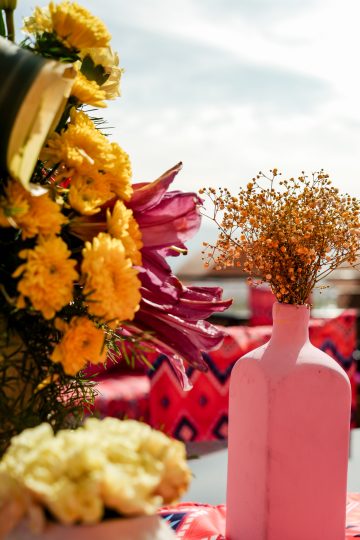From Vibrant Beginnings to Tearful Goodbyes: Punjabi Wedding Traditions
Punjabi weddings are renowned for their infectious energy, vibrant colors, and heartfelt traditions. As wedding planners in Jaipur, we love seeing the lively spirit they bring! While grand in celebration, the core rituals are deeply symbolic, creating a beautiful blend of fun and reverence. Let’s explore some key Punjabi wedding customs, from the joyous pre-wedding events to the emotional Vidaai.
The Celebratory Journey Begins
Punjabi weddings are a series of events, each with its own significance:
- Roka & Thaka: The initial “stop” to finding partners, where families formally agree to the match. The bride’s family visits the groom’s home (Roka), and the groom’s family reciprocates (Thaka), exchanging gifts and blessings. It’s the official start!
- Chunni Ceremony: The groom’s family presents the bride with a beautiful red chunni (scarf/dupatta) and gifts, welcoming her into their fold. This signifies their acceptance and blessing of her.
- Sagai (Engagement): A more public affair where rings are exchanged, making the engagement official. It’s often a lively gathering of friends and family.
- Sangeet & Mehndi: The ultimate pre-wedding party! The Sangeet is an evening of music, dance, and choreographed performances from both sides of the family. The Mehndi involves intricate henna designs on the bride’s hands and feet, and often for female guests too. These nights are pure fun!
- Jaggo: A festive ritual the night before the wedding, where family members carry decorated pots (jaggo) on their heads, singing and dancing, visiting relatives’ homes to invite them and celebrate. It’s loud, joyful, and full of energy!
- Mayian & Haldi: A purifying ceremony where a paste of turmeric, mustard oil, and other ingredients is applied to the bride and groom at their respective homes. It’s believed to cleanse them and give a radiant glow for the wedding day.

The Main Event: Wedding Day Rituals
The wedding day is filled with sacred moments and joyous celebrations:
- Chooda Ceremony: One of the most emotional rituals for the bride. Her maternal uncle (Mama) and aunt (Mami) present her with a set of red and ivory bangles (Chooda), purified in milk and rose petals. The bride’s eyes are often covered while the bangles are slipped on, symbolizing new beginnings and prosperity. Small, umbrella-shaped ornaments called Kalire are tied to the Chooda, and tradition says if a piece falls on an unmarried girl, she’s next to marry!
- Ghara Gharoli: After the Haldi, the bride’s sister-in-law brings holy water from a temple for the bride’s ceremonial bath.
- Kangna Bandhana: Sacred threads (mouli) are tied to the wrists of the bride and groom at their homes, blessed by a priest, to ward off evil and bring good fortune.
- Baraat & Milni: The groom’s grand procession to the wedding venue, often on a decorated horse (ghodi), accompanied by dancing family and friends and the beat of the dhol. The bride’s family formally welcomes the groom’s side in the Milni, where key family members embrace and exchange garlands.
- Varmala: The playful and joyous exchange of garlands between the bride and groom upon their meeting at the wedding stage, symbolizing their acceptance of each other.
- Anand Karaj (Sikh Wedding Ceremony): For Sikh weddings, this is the main ceremony performed in a Gurudwara. The couple circles the Guru Granth Sahib (holy scripture) four times (Laavan), signifying their vows and commitment.
- Pheras (Hindu Wedding Ceremony): In Hindu Punjabi weddings, the couple takes four or seven rounds (pheras) around the sacred fire, each step representing a vow for their married life.
- Joota Chupai: A fun, playful tradition where the bride’s sisters steal the groom’s shoes and demand a “ransom” for their return.

The Bittersweet Farewell: Vidaai Traditions
The wedding culminates in the emotional Vidaai (or Doli) ceremony, marking the bride’s departure from her parental home to her husband’s.
- Tears and Blessings: It’s a highly emotional moment for the bride and her family. She bids farewell to her parents, siblings, and relatives.
- Rice Shower: As she steps out of her home, the bride throws handfuls of rice over her head and backward towards her parents. This symbolizes her gratitude to her family for nurturing her and wishing them continued prosperity as she leaves to start her new life.
- Pushing the Car: Traditionally, the bride’s brothers push the decorated car that carries the couple, symbolizing their support for her new journey.
Punjabi weddings are a true spectacle of joy, family bonding, and cultural richness. Each tradition, big or small, plays a role in weaving together two families and celebrating a new beginning.

